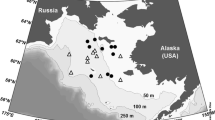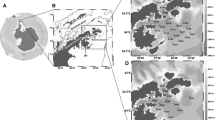Abstract
Ice-core observations were conducted at three arctic sites in early April 2003: one clean sediment-free site (Chukchi), one sediment-rich site (Beaufort) on landfast sea ice offshore Barrow, and one oceanic Ice Exercise (ICEX) site. Concentrations of inorganic nutrients at coastal sites were similar to but higher than those at the oceanic site. Chlorophyll-a (Chl-a) concentration was much higher in the Chukchi bottom ice than at the other two sites. However, large size Chl-a (>20 μm) dominated (>70%) the bottom-ice algal Chl-a at both the Chukchi and Beaufort sites, whereas the oceanic ICEX site was evenly occupied by large (>20 μm), medium (5–20 μm), and small Chl-a (0.7–5 μm). These in situ data were incorporated into an ocean-ecosystem model. The model results revealed that: (1) strong light attenuation by trapped sediments controlled ice-algal production at the Beaufort site; (2) the peak in ice algae occurred later at the oceanic site than at the Chukchi site because of thicker ice and the consequently reduced amount of light reaching the ice algae at the ice bottom; and (3) maximum production at the oceanic site reached only 10% the level at the Chukchi site because of nutrient limitation.




Similar content being viewed by others
References
Alexander V, Chapman T (1981) The role of epontic algal communities in Bering Sea ice. In: Hood DW, Calder JA (eds) The eastern bering sea shelf: oceanography and resources. University of Washington, Washington DC, pp 773–780
Andersen OGN (1989) Primary production, chlorophyll, light, and nutrients beneath the Arctic Sea ice. In: Herman Y (ed) The Arctic seas: climatology, oceanography, geology, and biology. Van Nostrand Reinhold company, New York, pp 147–191
Apollonio S (1965) Chl in Arctic sea ice. Arctic 18:118–122
Gosselin M, Levasseur M, Wheeler PA, Horner RA, Booth BC (1997) New measurements of phytoplankton and ice algal production in the Arctic Ocean. Deep-Sea Res 44:1623–1644
Gradinger RR, Kaufman MR, Bluhm BA (2009) Pivotal role of sea ice sediments in the seasonal development of near-shore Arctic fast ice biota. Mar Ecol Prog Ser 394:49–63
Jin M, Deal C, Wang J, Shin KH, Tanaka N, Whitledge TE, Lee SH, Gradinger R (2006) Controls of the landfast ice-ocean ecosystem offshore Barrow, Alaska. Ann Glaciol 44:63–72
Lavoie D, Denman K, Michel C (2005) Modeling ice algae growth and decline in a seasonally ice- covered region of the Arctic (Resolute Passage, Canadian Archipelago). J Geophys Res 110:C11009. doi:10.1029/2005JC002922
Lee SH (2005) Current primary production rates of the Western Arctic Ocean estimated by stable carbon and nitrogen isotope tracers. Ph.D. dissertation, University of Alaska, Fairbanks
Lee SH, Whitledge TE, Kang S-H (2008a) Spring time production of bottom ice algae in the landfast sea ice zone at Barrow, Alaska. J Exp Mar Biol Ecol 367:204–212
Lee SH, Whitledge TE, Kang S-H (2008b) Carbon uptake rates of sea ice algae and phytoplankton under different light intensities in a landfast sea ice zone, Barrow, Alaska. Arctic 61:281–291
Lizotte MP (2001) The contributions of sea ice algae to Antarctic marine primary production. Am Zool 41:57–73
Meguro H, Ito K, Fukushima H (1967) Ice flora (bottom type): a mechanism of primary production in polar seas and the growth of diatoms in sea ice. Arctic 20:14–133
Michel C, Nielsen TG, Nozais C, Gosselin M (2002) Significance of sedimentation and grazing by ice micro- and meiofauna for carbon cycling in annual sea ice (northern Baffin Bay). Aquat Microb Ecol 30:57–68
Parsons TR, Maita Y, Lalli CM (1984) A manual of chemical and biological methods for seawater analysis. Pergamon Press, New York, p 173
Perovich DK (1996) The optical properties of sea ice. CRREL Monogr 96(1), Cold Regions Research Engineering Laboratory, Hanover, NH
Perovich DK, Richter-Menge JA (2009) Loss of sea ice in the Arctic. Ann Rev Marine Sci 1:417–441
Redfield AC, Ketchum BH, Richards FA (1963) The influence of organisms on the composition of seawater. In: Hill MN (ed) The sea, vol 2. Interscience, New York, pp 26–77
Rothrock DA, Zhang J, Yu Y (2003) The arctic ice thickness anomaly of the 1990s: a consistent view from observations and models. J Geophys Res 108 doi: 10.1029/2001JC001208
Schnack-Schiel SB (2003) The macrobiology of sea ice. In: Thomas DN, Dieckman GS (eds) Sea ice: an introduction to its physics, chemistry, biology and geology. Blackwell Publishing Company, Oxford, pp 211–239
Tremblay C, Runge JA, Legendre L (1989) Grazing and sedimentation of ice algae during and immediately after a bloom at the ice-water interface. Mar Ecol Prog Ser 56:291–300
Vinnikov KY, Robock A, Stouffer RJ, Walsh JE, Parkinson CL, Cavalieri DJ, Mitchell JFB, Garrett D, Zakharov VF (1999) Global warming and northern hemisphere sea ice extent. Science 286:1934–1937
Webb DJ, Burnison BK, Trimbee AM, Prepas EE (1992) Comparison of chlorophyll a extractions with ethanol and dimethyl sulfoxide/acetone, and a concern about spectrophotometric phaeopigment correction. Can J Fish Aquat Sci 49:2331–2336
Whitledge TE, Malloy SC, Patton CJ, Wirick CD (1981) Automated nutrient analysis in seawater. Brookhaven National Laboratory Technical Report BNL 51398
Acknowledgments
This research was supported by the NOAA Ocean Exploration and Office of Arctic Research through CIFAR grants. We also appreciate financial support from KOPRI (PM09020) for completing this manuscript. Financial support from IARC/UAF and NPRB 607 was also appreciated.
Author information
Authors and Affiliations
Corresponding author
Rights and permissions
About this article
Cite this article
Lee, S.H., Jin, M. & Whitledge, T.E. Comparison of bottom sea-ice algal characteristics from coastal and offshore regions in the Arctic Ocean. Polar Biol 33, 1331–1337 (2010). https://doi.org/10.1007/s00300-010-0820-1
Received:
Revised:
Accepted:
Published:
Issue Date:
DOI: https://doi.org/10.1007/s00300-010-0820-1




